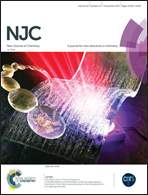A reduced graphene oxide@sulfur nanocomposite as a high-capacity host matrix for advanced lithium–sulfur batteries
Abstract
Nanosheets of reduced graphene oxide are a promising cathode material for achieving advanced Li/S batteries with high energy density and high performance. Herein, we report a procedure to synthesize a reduced graphene oxide (RGO) conductive matrix for trapping nanosulfur particles and polysulfide intermediates that impede sulfur from depositing onto the external surface of the carbon wall. The obtained results demonstrated high specific capacities and good cycling stability of the proposed cathode. The RGO@S cathode renders the discharge capacities of 1131.5, 991.45, 799.23, 765.2, and 645.76 mA h g−1 at the different current rates of 0.1, 0.2, 0.5, 1, and 2C, respectively. Moreover, high specific discharge capacity of about 593.2 mA h g−1 was delivered at a rate of 1C after 300 cycles of charge/discharge process with a reduced capacity of about 22.5%. As explained, the RGO@S structure has high potential as a cathode of next generation of lithium–sulfur batteries with high energy and power density.



 Please wait while we load your content...
Please wait while we load your content...